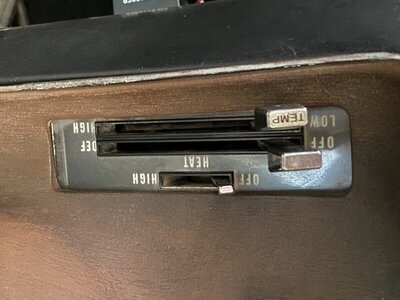MoparGuy68
Well-Known Member
I completely back flushed my 383 block, and heater core. And forward flushed the 26" radiator (was too inconvenient at the time to black flush it). Afterwards I blew block, heater core and radiator out with compressed air. So the system was dry, totally empty. I installed all hoses, and a new 180 degree thermostat, I did NOT leave the thermostat out.
I then filled the radiator, with 50/50 mix conventional green coolant, so that the level was 1.25" below the bottom of the radiator neck. Next morning after seeing the level had dropped some, I added more to get it at the 1.25" level. At this point I had added only a total of a little over 2 gallons of 50/50 coolant. The manual states the system should take 3.6 gallons.
Reading the following in the service manual..
Service manual says:
(5) Fill Cooling system to 1-1/4" below filler neck, using soft water and anti-freeze, depending on season or if equipped with A/C.
(6) Engine should be operated until temperature gauge indicates normal operating temperature, then continue an additional five minutes to release any air trapped in system.
(7) Check for leaks and coolant level; correct as necessary.
Started the engine for the first time in 5 months, with the radiator cap removed from the radiator.
Engine fired up, kicking up to fast idle speed. I let it run a little bit, then tapped the throttle to drop down to curb idle. Looked in radiator, coolant level had gone down only a little bit. I added a bit more coolant to get it about 1.25 below the filler neck bottom.
Then this is where things went horribly wrong.. As temperature gauge started to reach normal operating temperature (second tick mark from left on temp gauge in rallye dash), coolant started bubbling out of the radiator neck. I panicked, and turn the engine off.. When I did this, coolant started erupting out of the radiator neck like a volcano!! It went ALL over the place!! Drenching the radiator and the entire front of the engine. Got the Borgeson gearbox wet, the power steering pump and pulley. Spilled out onto the garage floor. It made a huge mess! I spent an hour sopping up coolant with paper towels, sponges and a mop.
Instruction in step 6 and 7 above are completely inadequate.. I now have no idea how to fill the system. If I was supposed to have the radiator cap in place, how am I supposed to check the coolant level and correct as necessary? There was still close to 1.5 gallons of coolant that needed to be added at the time of the eruption. At the time it erupted there was only a little over 2 gallons in the whole system.
Could someone please explain how step 6 and 7 should actually be performed in detail, so I don't repeat this disaster again?
I then filled the radiator, with 50/50 mix conventional green coolant, so that the level was 1.25" below the bottom of the radiator neck. Next morning after seeing the level had dropped some, I added more to get it at the 1.25" level. At this point I had added only a total of a little over 2 gallons of 50/50 coolant. The manual states the system should take 3.6 gallons.
Reading the following in the service manual..
Service manual says:
(5) Fill Cooling system to 1-1/4" below filler neck, using soft water and anti-freeze, depending on season or if equipped with A/C.
(6) Engine should be operated until temperature gauge indicates normal operating temperature, then continue an additional five minutes to release any air trapped in system.
(7) Check for leaks and coolant level; correct as necessary.
Started the engine for the first time in 5 months, with the radiator cap removed from the radiator.
Engine fired up, kicking up to fast idle speed. I let it run a little bit, then tapped the throttle to drop down to curb idle. Looked in radiator, coolant level had gone down only a little bit. I added a bit more coolant to get it about 1.25 below the filler neck bottom.
Then this is where things went horribly wrong.. As temperature gauge started to reach normal operating temperature (second tick mark from left on temp gauge in rallye dash), coolant started bubbling out of the radiator neck. I panicked, and turn the engine off.. When I did this, coolant started erupting out of the radiator neck like a volcano!! It went ALL over the place!! Drenching the radiator and the entire front of the engine. Got the Borgeson gearbox wet, the power steering pump and pulley. Spilled out onto the garage floor. It made a huge mess! I spent an hour sopping up coolant with paper towels, sponges and a mop.
Instruction in step 6 and 7 above are completely inadequate.. I now have no idea how to fill the system. If I was supposed to have the radiator cap in place, how am I supposed to check the coolant level and correct as necessary? There was still close to 1.5 gallons of coolant that needed to be added at the time of the eruption. At the time it erupted there was only a little over 2 gallons in the whole system.
Could someone please explain how step 6 and 7 should actually be performed in detail, so I don't repeat this disaster again?

















